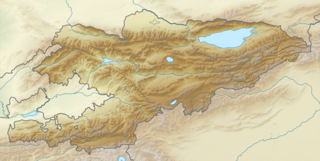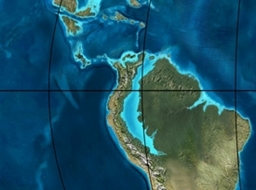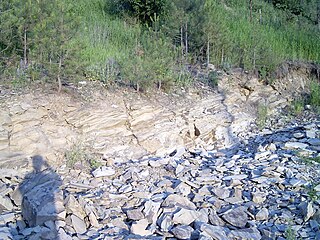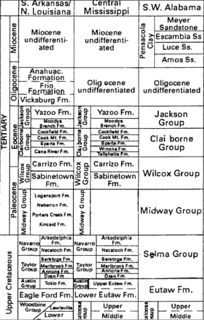 W
WThe Ieper Group is a group of rock strata in the subsurface of northwest Belgium. The group is subdivided into three marine formations, all formed during the Ypresian, a single age of the geologic timescale. Both age and group are named after the West-Flemish town of Ypres, for which the Dutch name is "Ieper".
 W
WThe Alai Beds is an Early Eocene geologic formation in the Osh Region of southwestern Kyrgyzstan. The formation has provided many fossils of mammals, lizards, turtles and snakes.
 W
WThe Argiles d'lignite du Soissonnais is a geologic formation in the Oise department of northern France. The formation has provided fossil mammals, reptiles and fish as well as arthropods in the amber of the formation. The Argiles d'lignite du Soissonnais dates back to the Ypresian stage of the Eocene period.
 W
WThe Bashi Formation is a geologic formation in Alabama and Mississippi. It is named for Bashi Creek in northern Clarke County, Alabama, which cuts through some of its exposures. It preserves fossils dating back to the Eocene period, or Wasatchian in the NALMA classification.
 W
WThe Black Crow Limestone is an Early Eocene geologic formation in the Sperrgebiet, ǁKaras Region of southwestern Namibia. The limestones of the approximately 10 metres (33 ft) thin formation were deposited in a lacustrine to paludal environment. The formation provides many fossil mammals and amphibians, reptiles, fresh water snails and fish.
 W
WThe Bogotá Formation (Spanish: Formación Bogotá, E1-2b, Tpb, Pgb) is a geological formation of the Eastern Hills and Bogotá savanna on the Altiplano Cundiboyacense, Eastern Ranges of the Colombian Andes. The predominantly shale and siltstone formation, with sandstone beds intercalated, dates to the Paleogene period; Upper Paleocene to Lower Eocene epochs, with an age range of 61.66 to 52.5 Ma, spanning the Paleocene–Eocene Thermal Maximum. The thickness of the Bogotá Formation ranges from 169 metres (554 ft) near Tunja to 1,415 metres (4,642 ft) near Bogotá. Fossils of the ungulate Etayoa bacatensis have been found in the Bogotá Formation, as well as numerous reptiles, unnamed as of 2017.
 W
WChiyli is an impact crater in Kazakhstan.
 W
WThe Chota Formation is an Early Campanian to Late Eocene geologic formation of the Cajamarca and western Amazonas Region in northern Peru. Dinosaur remains are among the fossils that have been recovered from the formation, although none have yet been referred to a specific genus. The formation was formerly named Bagua Formation.
 W
WThe Coalmont Formation (Tmc) is a geologic formation that outcrops in the North Park intermountaine basin in Colorado. It contains fossil plants and coal layers dating back to the Paleogene period.
 W
WThe Coldwater Beds is a geologic formation of the Okanagan Highlands in British Columbia, Canada. It preserves fossils dating back to the Ypresian stage of the Eocene period, or Wasatchian in the NALMA classification.
 W
WThe Cuchara Formation is a geologic formation in Colorado. It preserves fossils dating back to the Ypresian stage of the Eocene period, or Wasatchian in the NALMA classification.
 W
WThe Danata Formation is an Upper Paleocene to Middle Eocene sedimentary succession located in Turkmenistan. It is mostly famous for its fish-bearing horizons (Ichthyofauna). The formation for example crops out in the Kopet Dag mountain range in the border region of Turkmenistan and Iran.
 W
WThe DeBeque Formation is a geologic formation in Colorado's Piceance Basin, preserving fossils which date back to the Late Paleocene to Early Eocene period (Clarkforkian to Wasatchian in the NALMA classification. Examples of these fossils are held in the University of Colorado Museum of Natural History.
 W
WThe Fur Formation is a marine geological formation of Ypresian age which crops out in the Limfjord region of Denmark from Silstrup via Mors and Fur to Ertebølle, and can be seen in many cliffs and quarries in the area. The Diatomite Cliffs is on the Danish list of tentative candidates for World Heritage and may become a world Heritage site.
 W
WThe Golden Valley Formation is a stratigraphic unit of Late Paleocene to Early Eocene age in the Williston Basin of North Dakota. It is present in western North Dakota and was named for the city of Golden Valley by W.E. Benson and W.M. Laird in 1947. It preserves significant assemblages of fossil plants and vertebrates, as well as mollusk and insect fossils.
 W
WThe Gosau Group is a geological stratigraphic group in Austria, Germany and western Slovakia whose strata date back to the Late Cretaceous to Eocene. It is exposed in numerous sporadic isolated basins within the Northern Calcareous Alps. It is divided into two subgroups, the Lower Gosau Subgroup which dates from the Turonian to Campanian, approximately 90 to 75 Ma and the Upper Gosau Subgroup which dates to the Santonian to Eocene, about 83.5 to 50 Ma. The formations within each subunit vary significantly between basins. The sequence is largely marine, but the Grünbach Formation represents a terrestrial deposit. Many of the units of the group are fossiliferous, typically providing marine fossils such as ammonites, though terrestrial remains including those of dinosaurs are known from the Grünbach Formation and Schönleiten Formation.
 W
WThe Hannold Hill Formation is an Early Eocene (Wasatchian) geologic unit in the western United States. It preserves the fossilized remains of the ray Myliobatis and gar.
 W
WThe Hatchetigbee Bluff Formation is a geologic formation in Alabama, Georgia, Louisiana and Mississippi. The youngest unit of the Wilcox Group preserves fossils dating back to the Ypresian stage of the Eocene period, or Wasatchian in the NALMA classification. The formation is named for Hatchetigbee Bluff on the Tombigbee River, Washington County, Alabama.
 W
WThe Huitrera Formation is a geological formation in the Neuquén Basin in northern Patagonian Argentina whose strata date back to the Early Eocene of the Paleogene, or Casamayoran in the South American land mammal age classification.
 W
WThe Indian Meadows Formation is a Wasatchian geologic formation in Wyoming. It preserves fossils dating back to the Ypresian stage of the Eocene period.
 W
WThe Itaboraí Formation is a highly fossiliferous geologic formation and Lagerstätte of the Itaboraí Basin in Rio de Janeiro, southeastern Brazil. The formation reaching a thickness of 100 metres (330 ft) is the defining unit for the Itaboraian South American land mammal age (SALMA), dating to the Early Eocene, approximately 53 to 50 Ma.
 W
WThe Klondike Mountain Formation is an Early Eocene (Ypresian) geological formation located in the northeast central area of Washington state. The formation, named for the type location designated in 1962, Klondike Mountain north of Republic, Washington, is composed of volcanic rocks in the upper unit and volcanics plus lacustrine (lakebed) sedimentation in which a lagerstätte with exceptionally well-preserved plant and insect fossils has been found, along with fossil epithermal hot springs.
 W
WThe Laguna del Hunco Formation or Laguna del Hunco Tuff is a localized Early Eocene fossiliferous geological formation of the Cañadón Asfalto Basin in central Patagonia, Argentina. The 170 metres (560 ft) thick formation comprises tuffaceous mudstones and sandstones deposited in a crater lake environment and crops out at Laguna del Hunco in the northwestern Chubut Province.
 W
WThe Lambeth Group is a stratigraphic group, a set of geological rock strata in the London and Hampshire Basins of southern England. It comprises a complex of vertically and laterally varying gravels, sands, silts and clays deposited between 56-55 million years before present during the Ypresian age. It is found throughout the London Basin with a thickness between 10m and 30m and the Hampshire Basin with a thickness between 50m and less than 25m. Although this sequence only crops out in these basins, the fact that it underlies 25% of London at a depth of less than 30m means the formation is of engineering interest for tunnelling and foundations.
 W
WThe Las Tetas de Cabra Formation is a geologic formation in Mexico. It preserves fossils dating back to the Wasatchian of the Early Eocene period.
 W
WLebu Group is stratigraphic unit of Arauco Basin in south-central Chile. The group consists of a sequence of four formations, of both marine and nonmarine origin, deposited between the Early Paleocene and Middle Eocene.
 W
WThe Lechería Limestone is a geologic formation in Chiapas, Mexico. The shallow reefal biomicrite and mud-supported oolitic and pelletoidal biosparite limestones preserve fossils dating back to the Paleogene period.
 W
WThe Lignites de Soissonais is a geologic formation in the Var, Marne departments of France. It preserves fossils dating back to the Ypresian stage of the Eocene period.
 W
WThe London Clay Formation is a marine geological formation of Ypresian age which crops out in the southeast of England. The London Clay is well known for its fossil content. The fossils from the lower Eocene rocks indicate a moderately warm climate, the tropical or subtropical flora. Though sea levels changed during the deposition of the clay, the habitat was generally a lush forest – perhaps like in Indonesia or East Africa today – bordering a warm, shallow ocean.
 W
WThe Margaret Formation is a geologic formation of the Eureka Sound Group in the Sverdrup Basin in Northwest Territories and Nunavut, Canada. The unit belonging to the Eureka Sound Group which crops out at Ellesmere Island preserves fossils dating back to the Early Eocene period, or Wasatchian in the NALMA classification.
 W
WThe Nanjemoy Formation is a geologic formation pertaining to both the Wilcox Group and the Pamunkey Group of the eastern United States, stretching across the states of Virginia, Maryland, and District of Columbia. The formation crops out east of the Appalachians and dates back to the Paleogene period. Specifically to the Ypresian stage of the Eocene epoch, about 55 to 50 Ma or Wasatchian in the NALMA classification, defined by the contemporaneous Wasatch Formation of the Pacific US coast.
 W
WThe Pass Peak Formation is a Wasatchian geologic formation in Wyoming. It preserves fossils dating back to the Ypresian stage of the Eocene period.
 W
WThe San Jose Formation is an Early Eocene geologic formation in the San Juan Basin of New Mexico and Colorado.
 W
WThe Silveirinha Formation is an Early Eocene geologic formation of the Mondego Basin in the Região Centro of central-western Portugal. The sandstones, siltstones and conglomerates were deposited in an alluvial environment.
 W
WThe Tatman Formation is a Wasatchian geologic formation in Wyoming. It preserves fossils dating back to the Ypresian stage of the Eocene period.
 W
WThe Wasatch Formation (Tw) is an extensive highly fossiliferous geologic formation stretching across several basins in Idaho, Montana Wyoming, Utah and western Colorado. It preserves fossils dating back to the Early Eocene period. The formation defines the Wasatchian or Lostcabinian, a period of time used within the NALMA classification, but the formation ranges in age from the Clarkforkian to Bridgerian.
 W
WThe Wilcox Group is an important geologic group in the Gulf of Mexico Basin and surrounding onshore areas from Mexico and Texas to Louisiana and Alabama. The group ranges in age from Paleocene to Eocene and is in Texas subdivided into the Calvert Bluff, Simsboro and Hooper Formations, and in Alabama into the Nanafalia and Hatchetigbee Formations. Other subdivisions are the Lower, Middle and Upper Wilcox Subgroups, and the Carrizo and Indio Formations.
 W
WThe Willwood Formation is a sedimentary sequence deposited during the late Paleocene to early Eocene, or Clarkforkian, Wasatchian and Bridgerian in the NALMA classification.